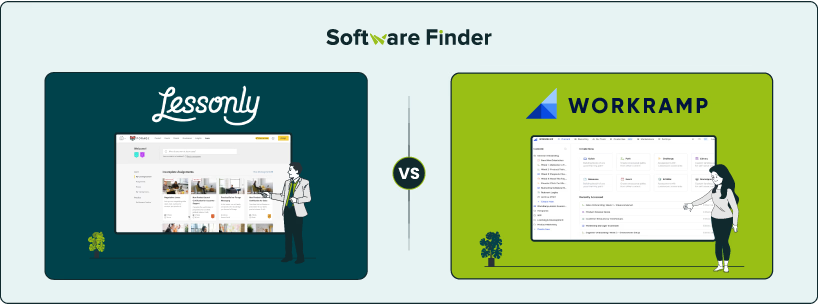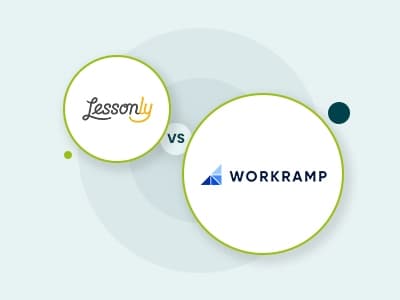
Selecting the right learning management system (LMS) isn't just about features. It's about finding a platform that drives tangible business outcomes. The right LMS accelerates onboarding, improves sales performance, and scales customer education while aligning with your organization's broader goals.
Lessonly (now Seismic Learning) and WorkRamp are both powerful LMS platforms, but they serve different needs. Lessonly focuses on helping sales teams ramp up quickly with targeted coaching and practice tools. In contrast, WorkRamp provides a broad setup for training employees, customers, and partners all in one place. This guide breaks down their strengths to help you choose the right fit for your team.

Feature | Lessonly | WorkRamp |
Content Authoring
| Drag‑and‑drop lesson builder with multimedia and quizzes optimized for mobile use | Strong authoring: AI‑powered conversion of docs, templates, prebuilt content, plus SCORM uploads |
Reporting And Analytics | Readiness scorecards and manager dashboards to tie training to performance | Built‑in Report Builder with customizable dashboards, scheduled exports, and API/CSV sync |
User Experience And Interface | Clean, sales‑focused interface that ensures fast adoption and minimal training | Feature‑rich UI supporting branding, microlearning, social learning, and interactive elements |
Integration Support | Strong sales-stack integrations (Salesforce, Outlook, Teams) with the Seismic Exchange marketplace | Extensive connectivity: Slack, Salesforce, Zoom, Udemy, LinkedIn Learning, Zapier, and public API |
AI-Powered Coaching | An AI assistant integrated into sales workflows offering real-time coaching, content suggestions, and performance insights. | Immersive role-play bots embedded in training guides for self-paced coaching and instant feedback |
Lessonly (now Seismic Learning) is a streamlined training and coaching platform designed for customer-facing teams, particularly in sales and marketing, across various industries, including financial services. It unifies interactive lesson creation, coaching tools, and performance tracking in a single workspace to support continuous skill development.
The platform simplifies onboarding, reinforces key messaging, and helps close skill gaps through bite-sized lessons, practice modules, and structured feedback loops. By integrating content, coaching, and analytics into daily routines, Lessonly ensures that customer-facing representatives receive practical guidance closely linked to real-world interactions.
Unique Features Of Lessonly

- Faster Onboarding: The platform highlights the ability to ramp reps quickly using a structured onboarding approach
- Practice-based Learning: Interactive practice lessons, such as role plays and knowledge checks to reinforce learning effectively
- Sales-oriented Focus: Designed for sales and customer-facing teams to improve onboarding, certification, and ongoing readiness
Pros And Cons Of Lessonly
Pros
- Shared lessons auto-update across multiple curriculums, saving time and effort
- Keeps documents organized with easy indexing
- Built-in quiz tools make knowledge checks seamless and interactive within lessons
Cons
- Customization options are limited; users can't modify everything to their preference
- Lesson layouts feel rigid; additional two-column formats would be helpful
WorkRamp is a learning platform that brings together employee, customer, and partner training under one roof, allowing companies to manage all their learning programs in a single platform. It’s well-suited for industries like technology and professional services, where efficiently training diverse audiences is critical, replacing the need for multiple tools and streamlining the training experience across teams.
Additionally, the platform provides AI-driven insights to identify skill gaps and recommends personalized learning paths tailored to individual needs. Its collaborative course creation tools ensure content remains fresh, relevant, and aligned with evolving business goals.
Unique Features Of WorkRamp

- AI-Powered Content Creation: Helps teams create training materials faster and brainstorm new content ideas
- Collaborative Editing Environment: Assist in simultaneous editing of training content in real-time
- Global Learning Support: Offers multi-lingual training tools for international teams across various countries
Pros And Cons Of WorkRamp
Pros
- The drag-and-drop setup is ideal for quick quiz and training creation
- Regularly updated with the latest technology, ensuring training tools remain modern and effective
- Enables non-training staff to easily create and share content across teams, boosting knowledge-sharing company-wide
Cons
- Reporting interface lacks flexibility for analyzing content and learning paths
- No offline mode, learning content requires an internet connection to access
Choosing between Lessonly and WorkRamp depends on your organization's priorities and audience. If you need a sales-centric enablement platform that embeds real-time coaching and training directly into your sales stack, Lessonly offers a more targeted and user-friendly approach.
However, if your organization's priority is building intelligent, interactive learning aimed at diverse audiences and backed by strong analytics and integrations, WorkRamp is the better choice.
Ready to discover which platform best suits your needs? We can help you connect your goals with the right solution. Contact us today for expert guidance.
